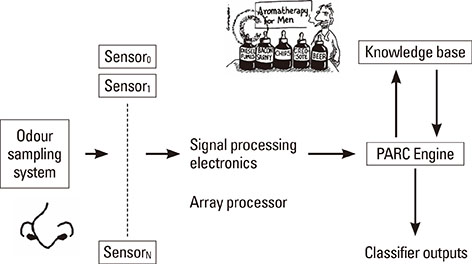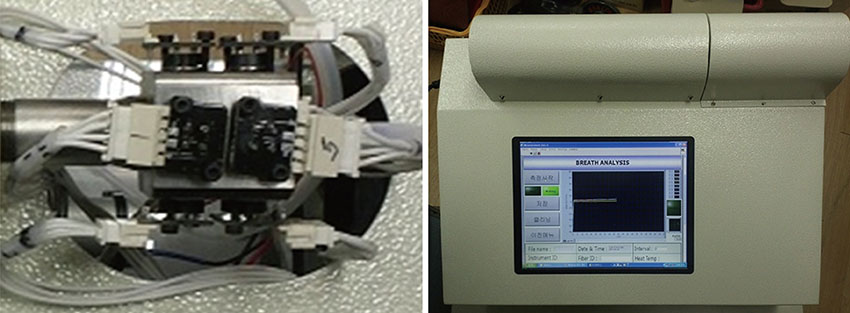Hanyang Med Rev.
2014 Aug;34(3):125-129. 10.7599/hmr.2014.34.3.125.
Exhaled Breath Analysis System based on Electronic Nose Techniques Applicable to Lung Diseases
- Affiliations
-
- 1Division of Electronics, Information & Communication Engineering, Kangwon National University, Samcheok Campus, Samchek, Korea. byun@kangwon.ac.kr
- 2Department of Material Science and Metallurgy, Kyungpook National University, Daegu, Korea.
- 3Biomedical Research Institute, Kyungpook National University Hospital, Daegu, Korea.
- KMID: 2284353
- DOI: http://doi.org/10.7599/hmr.2014.34.3.125
Abstract
- Smell used to be a common diagnostic tool in medicine, and physicians were trained to use their sense of smell during their medical training. Latterly, odor disgnostics have been relegated to secondary status as a diagnostic method. Array-based gas sensors ("Electronic Nose") now offer the potential of a robust analytical approach to exhaled breath analysis for medical use. Many diseases are accompanied by characteristic odor, and their recognition can provide diagonostic clues, guide the laboratory evaluation, and affect the choice of immediate therapy. We are developing an intelligent sensor system for non-invasive health care monitoring combined laboratory based sensor module, pattern recognition subsystem and non-invasive sampling of volatile emitted from a patient into a highly intelligent sensor system that allows the rapid processing of these samples. It is capable to assist early and rapid disgnosis of changes in state of patient, and aid decision making by medical personnel in the treatment of such patients. In this paper, we introduce exhaled breath analysis for potential primary lung disease screening using electronic nose system incorporating an automated solid-phase microextraction (SPME) desorption to enable the system to be used. Aiming to increase the sensitivity, SPME preconcentration is used for sampling of headspace air and the response of sensor module to variable concentration of volatile emitted from SPME fiber is evaluated. The initial result shows the distinguished difference between the lung cancer patients and healthy normal individuals according to the analysis of the respective expiratory gases.
MeSH Terms
Figure
Cited by 1 articles
-
Unravel the Secret of Olfaction
Seok Hyun Cho
Hanyang Med Rev. 2014;34(3):97-99. doi: 10.7599/hmr.2014.34.3.97.
Reference
-
1. Liddell K. Smell as a diagnostic marker. Postgrad Med J. 1976; 52:136–138.
Article2. Hakim M, Broza YY, Barash O, Peled N, Phillips M, Amann A, et al. Volatile organic compounds of lung cancer and possible biochemical pathways. Chem Rev. 2012; 112:5949–5966.
Article3. Tisch U, Billan S, Ilouze M, Phillips M, Peled N, Haick H. Volatile organic compounds in exhaled breath as biomarkers for the early detection and screening of lung cancer. CML-Lung Cancer. 2012; 5:107–117.
Article4. Gradner J, Bartlett P. Electronic noses principles and applications. Meas Sci Technol. 2000; 11:20–25.5. Bishop L. Application of chemometric methods applied to breath analysis. Bedfordshire: Cranfield University;2006. p. 8–11.6. Pearce TC. Computational parallels between the biological olfactory pathway and its analogue 'the electronic nose': Part II. Sensor-based machine olfaction. Biosystems. 1997; 41:69–90.
Article7. Cesare F, Pantalei S, Zampetti E, Macagnano A. Electronic nose and SPME techniques to monitor phenanthrene biodegradation in soil. Sensor Actuat B-Chem. 2008; 131:63–70.
Article8. Krizek TJ, Robson MC. Evolution of quantitative bacteriology in wound management. Am J Surg. 1975; 130:579–584.
Article9. Peng G, Tisch U, Adams O, Hakim M, Shehada N, Broza YY, et al. Diagnosing lung cancer in exhaled breath using gold nanoparticles. Nat Nanotechnol. 2009; 4:669–673.
Article10. Figaro USA Inc. The Leader in Semiconductor Gas Sensor Technology. West Lake Ave(USA): Figaro USA Inc;c2013. cited 2014 May 3. Available from: http://www.figarosensor.com/.11. Phillips M, Gleeson K, Hughes JM, Greenberg J, Cataneo RN, Baker L, et al. Volatile organic compounds in breath as markers of lung cancer: a cross-sectional study. Lancet. 1999; 353:1930–1933.
Article
- Full Text Links
- Actions
-
Cited
- CITED
-
- Close
- Share
- Similar articles
-
- Measurements of fractional exhaled nitric oxide in pediatric asthma
- Development of a Breath Control Training System for Breath-Hold Techniques and Respiratory-Gated Radiation Therapy
- Correction of the Deviated Nose in Korean Rhinoplasty
- Use of the exhaled nitric oxide for management of asthma and respiratory diseases
- Change of the Peak Inspiratory Airway Pressure and Exhaled Volume during One Lung Ventilation





